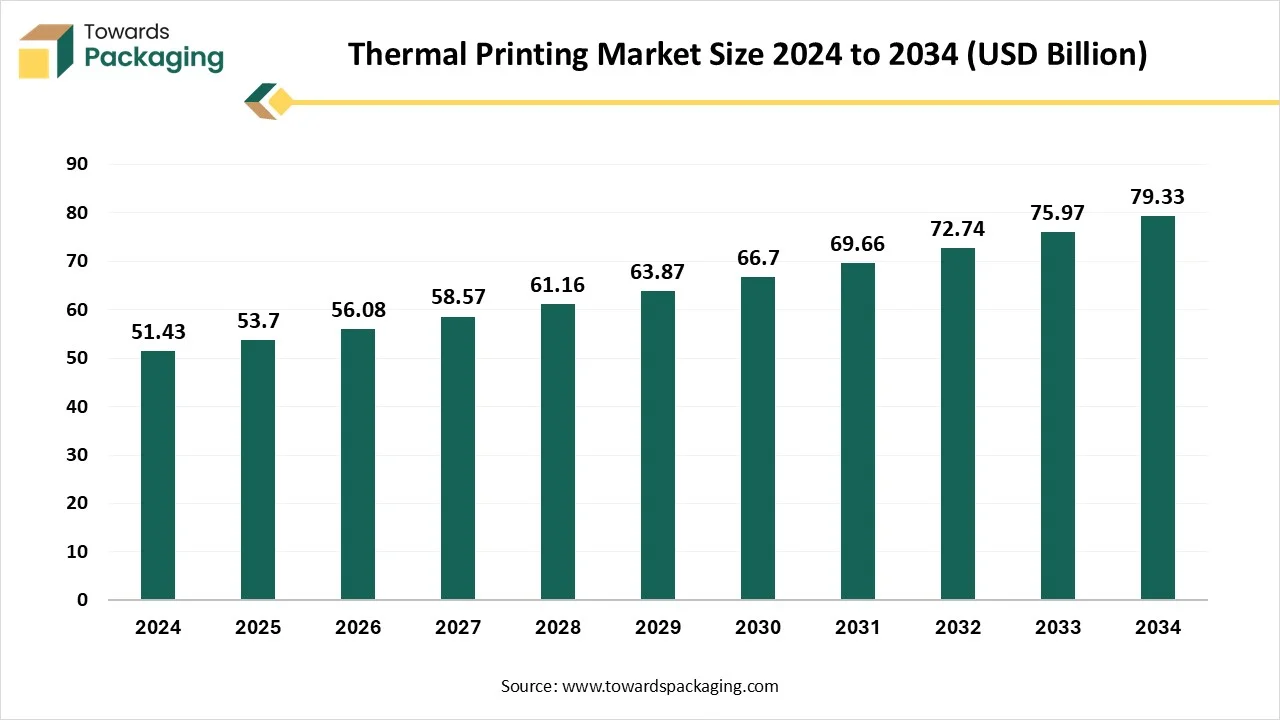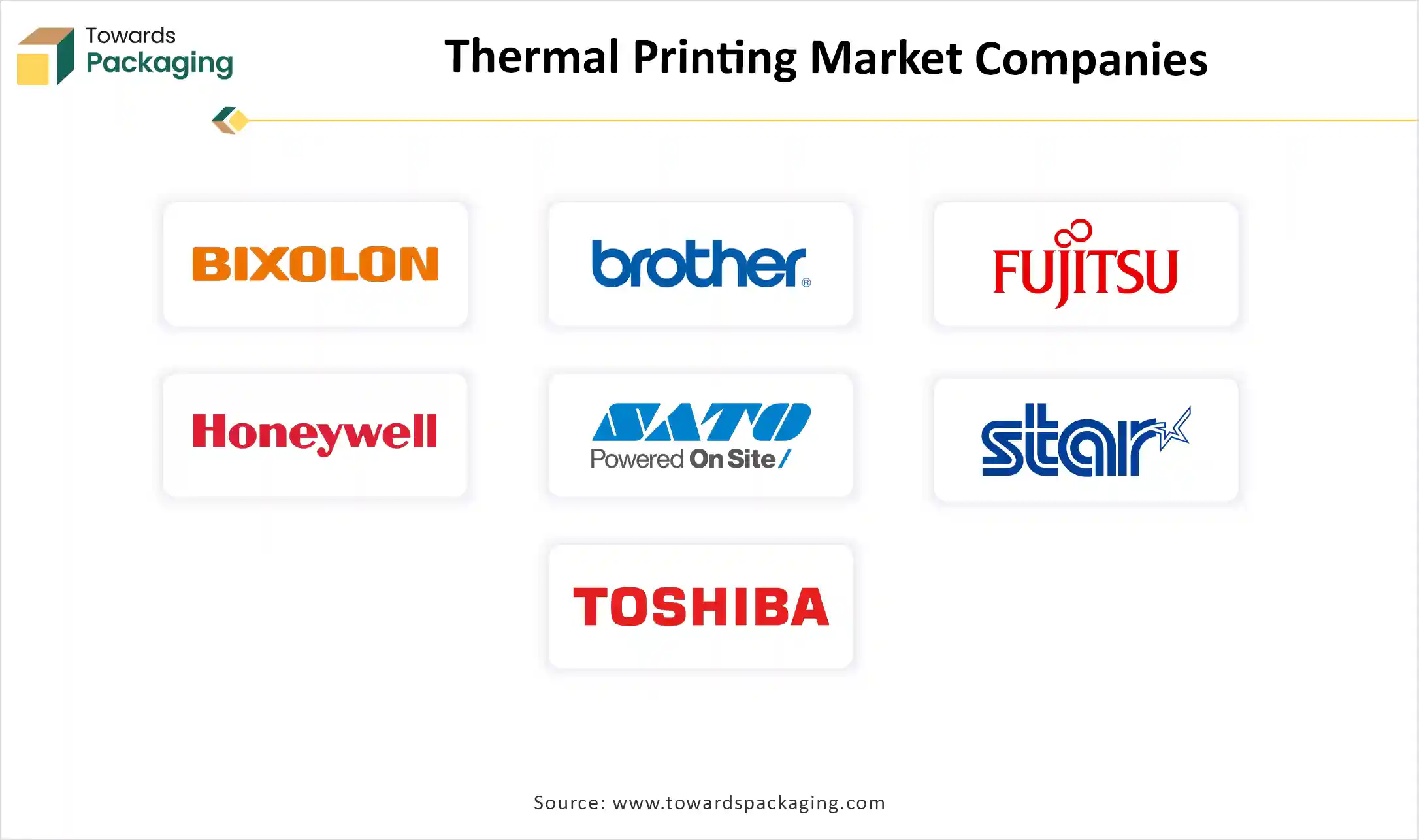October 2025
The thermal printing market is projected to reach USD 79.33 billion by 2034, growing from USD 53.70 billion in 2025, at a CAGR of 4.43% during the forecast period from 2025 to 2034.This market proliferates due to the growing demand for label printing, particularly in barcode printing in various industries. Durability, high-speed printing, and cost-effectiveness make the thermal label printers an ideal label printing solution in various industries. Industries like retail, healthcare, and hospitality are heavily using thermal label printing in their daily operations. This and many other factors are driving the market growth and are expected to continue during the forecast period.

The thermal printing market is showing substantial growth due to many factors, such as printing requirements for digitally printed bills, barcode printing, receipts, ticket printing, and shipping labels printing. All these operations require fast, durable, and cost-effective printing solutions. A thermal label printer is the perfect printing solution for various industrial requirements. It is high speed, it offers highly durable smudge-proof printing, and it is very cost-effective, making it a popular choice in its various applications.
Automation in supply chain labelling is driving the growth of the thermal printing market. Growth of industries like retail transportation & logistics, manufacturing, healthcare, and hospitality is impacting the growth of the thermal printing market. Continuous technological advancements are reducing the printing cost and enhancing the printing speed and quality. Compared to other printing technologies like inkjet and laser printing the thermal printing requires less maintenance, hence making it a very cost-effective solution. and its smudge-proof printing is very reliable in harsh conditions, which makes it a perfect choice for shipping labels and travel tickets printing in railway, etc. All these factors are driving the growth of the thermal printing market and are expected to continue during the upcoming period.
| Metric | Details |
| Market Size in 2024 | USD 51.43 Billion |
| Projected Market Size in 2034 | USD 79.33 Billion |
| CAGR (2025 - 2034) | 4.43% |
| Leading Region | North America |
| Market Segmentation | By Type, By Technology, By Format, By Offering, By Application and By Region |
| Top Key Players | BIXOLON Co., Ltd., Brother Industries Ltd., Fujitsu Ltd., Honeywell International Inc., SATO Holdings Corporation |
AI integration in thermal label printers is increasing the printing quality and working on cost-effective printing. AI-powered software tools can analyze in advance if there is any design-related error, which saves the material wastage after printing. Highly sophisticated designs for labels can be created using AI design tools. Integration of AI and ERP systems can generate the labels automatically without any manual intervention. and the smart labels created using intelligent AI systems can help in live product tracking while shipping, creating smart consumer interactive labels and labels intended for anti-counterfeiting in sensitive shipments such as health care and pharmaceuticals.
AI-driven predictive maintenance is helping in the timely maintenance of the machine, which helps in maintaining the quality of the machine for a long time. In the future, the AI will enable the use of other technologies such as IoT, cloud computing, and ERP; the integration of all of these together will create a complete ecosystem. AI is enhancing the operational effectiveness, speed of execution, printing accuracy, and reduction in material wastage, all of this combined together increasing the business efficiency and profitability. While focusing on growth, AI is helping in optimizing the process and actively contributing in the sustainable printing solutions.
The e-commerce sector is rising exponentially on a global level, which has created a huge growth in logistics and transportation. For transporting millions of shipments with utmost accuracy, highly sophisticated labeling is essential. Thermal label printers are the best label printing solutions for e-commerce shipments, considering their requirements such as smudge-proof labeling during the transportation of the shipments, high-quality printing for QR codes, high-speed printing with cost-effectiveness, as there is a label printing requirement on a very large scale. In the retail sector high quality barcode printing is necessary for smoother scanning for the printing of the computer-generated. Receipts, the thermal printers are the most efficient printing solution in the retail sector. In logistics, the shipping labels are highly reliant upon thermal label printers due to durability, speed, and cost-effectiveness.
In recent times, the counterfeiting of products is increasing very rapidly, particularly in sensitive shipments like healthcare and pharmaceuticals. It is necessary to validate the authenticity of the shipments and products. In this case, the RFID and Smart labels, like QR codes, help in tracking the original product and ensure safety during the product shipments. Thermal printers provide high-quality QR code printing output, making it essential to use thermal label printers in QR code printing. This creating a massive demand in the thermal printing market.
Integration with cloud, AI, ERP systems, and effective wireless connectivity has enhanced the thermal label printers to the next level. Automation in thermal printers has made the printers very smart and effective, with integration with ERP to help generate automated labels based on data available in the system. Cloud integration enables a remote printing feature for the thermal label printers. Key market players are continuously working towards the enhancements of currently available technology, resulting in cost reduction, quality enhancement, and an increase in printing speed as the latest technology is coming to the market.
In the shipping industry, the digitally printed shipping labels using thermal label printer technology are providing the convenience of personalization and customization as per the requirement for each single unit. In e-commerce shipments, a unique QR code, name, shipment ID, and address etc. have to be printed on the shipment label. This is possible due to the thermal label printer connected with the system having all the details. These operations are only possible due to the latest printing technology and are not feasible to do manually at all. This dependency is making the use of thermal label printers inevitable for customization and personalized label printing.
Barcode printers dominated the market in 2024 due to their various application the many industries, such as e-commerce, retail, healthcare, logistics, etc. The excellent capability of thermal printers to produce high-quality, crisp, and clear labels with high speed at very large volumes with cost-effectiveness makes them an ideal choice in this industry for their specific applications. Its smudge-proof and durable nature makes it a popular choice for shipment labels. Rise in e-commerce, health care, and the manufacturing sectors is generating very high demand for barcode printers.
New technological advancements in barcode technology, such as 2D barcode and QR codes, are generating demand in the barcode printer market. POS printers, kiosk & ticket printers, RFID printers card printers are the other label printer categories contributing significantly to the thermal printing market.
Direct thermal technology offering a cost-effective, high-speed and reliable thermal label printing solution primarily used in applications such as barcode, receipts, labels and tickets where the use is for very short-term and printing durability is not a notable concern. In the retail sector and hospitality industry, the ease of use and execution speed make it a popular choice.
Whereas the thermal transfer technology, which is the fastest growing in the technology segment, offers better durability for an extended period, making it a popular choice in industries like manufacturing and warehousing. For printing the barcode on various types of materials, thermal transfer technology is highly preferred. Dye Diffusion Thermal Transfer technology is used in the premium quality color printing requirements, such as ID cards or photo identity.
The expansion of various industrial areas using thermal printers has promoted the dominance of industrial segment in 2024. Particularly, the barcode printers are widely used in industrial applications for various label printing, which makes them the dominating segment. Apart from this, the mobile format is the fastest growing due to its features like portability and wireless connectivity, and it is expected to grow significantly in the upcoming time.
By offering, the thermal printers segment led the thermal printing market in 2024. Unlike traditional ink-based printers, thermal printers do not require ink or toner, reducing long-term operational costs. Additionally, with the rapid growth in e-commerce, warehouse automation, and healthcare digitization, the demand for durable, smudge-resistant labels and receipts surged, further solidifying thermal printers as the go-to option. The dominance is due to their high-speed performance, low maintenance, and cost-efficiency—making them the preferred choice for sectors requiring bulk and continuous printing, such as retail billing, logistics labeling, and medical record tagging.
The retail segment is dominating the thermal printing market due to essential labeling requirements on a regular basis, such as price tags, barcodes, receipts, shipping labels, tamper-evident labels, discount coupons, etc. The healthcare and hospitality segment is the fastest-growing thermal printing market due to various applications such as smart labels, labels for patient tracking, labels on various medical devices, and labels for medical processes. Efficient labeling, identification, and documentation are essential processes to be followed. Patient identification, drug management, sample labeling, inventory management, and managing patient data are the various applications in the healthcare and hospitality industry for the thermal label printer. This growth is expected to continue in the upcoming period.
In various industries like retail, healthcare, logistics, and e-commerce North American region is dominating the market. The presence of key market players in the region is driving the dominance of the North American region in the thermal printing market. companies offering thermal label supplies, are also coming from this region. Zebra Technologies (US), Honeywell International (US), NCR Corporation (US), and Avery Dennison (US) are the key market players present in the North America region for the thermal printing market.
The European region shows notable growth in the thermal printer market due to various uses in healthcare and hospitality. the booming healthcare sector in Europe is driving the growth as there is increasing demand for healthcare services and support. Retail, e-commerce, and logistics industries are also showing significant growth.
The Asia-Pacific is showing the fastest growth in the thermal printing market due to the growing population with disposable incomes, growing retail, and ecommerce sectors. and followed by this, the logistics sector, expansion of the manufacturing sector and increasing consumer base in the Asia-Pacific region, driving the growth of the thermal printing market. The recent wave of digitalization in the Asia-Pacific region is heavily driving the demand for POS printers.

By Type
By Technology
By Format
By Offering
By Application
By Region
October 2025
October 2025
October 2025
October 2025